Class 7 Maths Chapter 5 – Lines and Angles
Exercise 5.1 Page: 101
1. Find the complement of each of the following angles:
(i)

Solution:-
Two angles are said to be complementary if the sum of their measures is 90o.
The given angle is 20o
Let the measure of its complement be xo.
Then,
= x + 20o = 90o
= x = 90o – 20o
= x = 70o
Hence, the complement of the given angle measures 70o.
(ii)
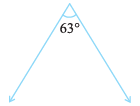
Solution:-
Two angles are said to be complementary if the sum of their measures is 90o.
The given angle is 63o
Let the measure of its complement be xo.
Then,
= x + 63o = 90o
= x = 90o – 63o
= x = 27o
Hence, the complement of the given angle measures 27o.
(iii)

Solution:-
Two angles are said to be complementary if the sum of their measures is 90o.
The given angle is 57o
Let the measure of its complement be xo.
Then,
= x + 57o = 90o
= x = 90o – 57o
= x = 33o
Hence, the complement of the given angle measures 33o.
2. Find the supplement of each of the following angles:
(i)

Solution:-
Two angles are said to be supplementary if the sum of their measures is 180o.
The given angle is 105o
Let the measure of its supplement be xo.
Then,
= x + 105o = 180o
= x = 180o – 105o
= x = 75o
Hence, the supplement of the given angle measures 75o.
(ii)

Solution:-
Two angles are said to be supplementary if the sum of their measures is 180o.
The given angle is 87o
Let the measure of its supplement be xo.
Then,
= x + 87o = 180o
= x = 180o – 87o
= x = 93o
Hence, the supplement of the given angle measures 93o.
(iii)
![]()
Solution:-
Two angles are said to be supplementary if the sum of their measures is 180o.
The given angle is 154o
Let the measure of its supplement be xo.
Then,
= x + 154o = 180o
= x = 180o – 154o
= x = 26o
Hence, the supplement of the given angle measures 93o.
3. Identify which of the following pairs of angles are complementary and which are supplementary.
(i) 65o, 115o
Solution:-
We have to find the sum of given angles to identify whether the angles are complementary or supplementary.
Then,
= 65o + 115o
= 180o
If the sum of two angle measures is 180o, then the two angles are said to be supplementary.
∴These angles are supplementary angles.
(ii) 63o, 27o
Solution:-
We have to find the sum of given angles to identify whether the angles are complementary or supplementary.
Then,
= 63o + 27o
= 90o
If the sum of two angle measures is 90o, then the two angles are said to be complementary.
∴These angles are complementary angles.
(iii) 112o, 68o
Solution:-
We have to find the sum of given angles to identify whether the angles are complementary or supplementary.
Then,
= 112o + 68o
= 180o
If the sum of two angle measures is 180o, then the two angles are said to be supplementary.
∴These angles are supplementary angles.
(iv) 130o, 50o
Solution:-
We have to find the sum of given angles to identify whether the angles are complementary or supplementary.
Then,
= 130o + 50o
= 180o
If the sum of two angle measures is 180o, then the two angles are said to be supplementary.
∴These angles are supplementary angles.
(v) 45o, 45o
Solution:-
We have to find the sum of given angles to identify whether the angles are complementary or supplementary.
Then,
= 45o + 45o
= 90o
If the sum of two angle measures is 90o, then the two angles are said to be complementary.
∴These angles are complementary angles.
(vi) 80o, 10o
Solution:-
We have to find the sum of given angles to identify whether the angles are complementary or supplementary.
Then,
= 80o + 10o
= 90o
If the sum of two angle measures is 90o, then the two angles are said to be complementary.
∴These angles are complementary angles.
4. Find the angles which is equal to its complement.
Solution:-
Let the measure of the required angle be xo.
We know that, sum of measures of complementary angle pair is 90o.
Then,
= x + x = 90o
= 2x = 90o
= x = 90/2
= x = 45o
Hence, the required angle measures is 45o.
5. Find the angles which is equal to its supplement.
Solution:-
Let the measure of the required angle be xo.
We know that, sum of measures of supplementary angle pair is 180o.
Then,
= x + x = 180o
= 2x = 180o
= x = 180/2
= x = 90o
Hence, the required angle measures is 90o.
6. In the given figure, ∠1 and ∠2 are supplementary angles. If ∠1 is decreased, what changes should take place in ∠2 so that both angles still remain supplementary.

Solution:-
From the question, it is given that,
∠1 and ∠2 are supplementary angles.
If ∠1 is decreased, then ∠2 must be increased by the same value. Hence, this angle pair remains supplementary.
7. Can two angles be supplementary if both of them are:
(i). Acute?
Solution:-
No. If two angles are acute, means less than 90o, the two angles cannot be supplementary. Because, their sum will be always less than 90o.
(ii). Obtuse?
Solution:-
No. If two angles are obtuse, means more than 90o, the two angles cannot be supplementary. Because, their sum will be always more than 180o.
(iii). Right?
Solution:-
Yes. If two angles are right, means both measures 90o, then two angles can form a supplementary pair.
∴90o + 90o = 180
8. An angle is greater than 45o. Is its complementary angle greater than 45o or equal to 45o or less than 45o?
Solution:-
Let us assume the complementary angles be p and q,
We know that, sum of measures of complementary angle pair is 90o.
Then,
= p + q = 90o
It is given in the question that p > 45o
Adding q on both the sides,
= p + q > 45o + q
= 90o > 45o + q
= 90o – 45o > q
= q < 45o
Hence, its complementary angle is less than 45o.
9. In the adjoining figure:
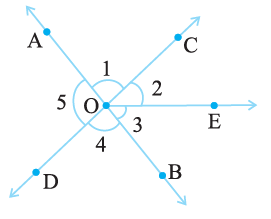
(i) Is ∠1 adjacent to ∠2?
Solution:-
By observing the figure we came to conclude that,
Yes, as ∠1 and ∠2 having a common vertex i.e. O and a common arm OC.
Their non-common arms OA and OE are on both the side of common arm.
(ii) Is ∠AOC adjacent to ∠AOE?
Solution:-
By observing the figure, we came to conclude that,
No, since they are having a common vertex O and common arm OA.
But, they have no non-common arms on both the side of the common arm.
(iii) Do ∠COE and ∠EOD form a linear pair?
Solution:-
By observing the figure, we came to conclude that,
Yes, as ∠COE and ∠EOD having a common vertex i.e. O and a common arm OE.
Their non-common arms OC and OD are on both the side of common arm.
(iv) Are ∠BOD and ∠DOA supplementary?
Solution:-
By observing the figure, we came to conclude that,
Yes, as ∠BOD and ∠DOA having a common vertex i.e. O and a common arm OE.
Their non-common arms OA and OB are opposite to each other.
(v) Is ∠1 vertically opposite to ∠4?
Solution:-
Yes, ∠1 and ∠2 are formed by the intersection of two straight lines AB and CD.
(vi) What is the vertically opposite angle of ∠5?
Solution:-
∠COB is the vertically opposite angle of ∠5. Because these two angles are formed by the intersection of two straight lines AB and CD.
10. Indicate which pairs of angles are:

(i) Vertically opposite angles.
Solution:-
By observing the figure we can say that,
∠1 and ∠4, ∠5 and ∠2 + ∠3 are vertically opposite angles. Because these two angles are formed by the intersection of two straight lines.
(ii) Linear pairs.
Solution:-
By observing the figure we can say that,
∠1 and ∠5, ∠5 and ∠4 as these are having a common vertex and also having non common arms opposite to each other.
11. In the following figure, is ∠1 adjacent to ∠2? Give reasons.

Solution:-
∠1 and ∠2 are not adjacent angles. Because, they are not lie on the same vertex.
12. Find the values of the angles x, y, and z in each of the following:
(i)
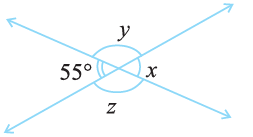
Solution:-
∠x = 55o, because vertically opposite angles.
∠x + ∠y = 180o … [∵ linear pair]
= 55o + ∠y = 180o
= ∠y = 180o – 55o
= ∠y = 125o
Then, ∠y = ∠z … [∵ vertically opposite angles]
∴ ∠z = 125o
(ii)
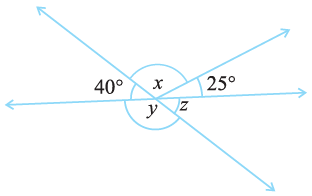
Solution:-
∠z = 40o, because vertically opposite angles.
∠y + ∠z = 180o … [∵ linear pair]
= ∠y + 40o = 180o
= ∠y = 180o – 40o
= ∠y = 140o
Then, 40 + ∠x + 25 = 180o … [∵angles on straight line]
65 + ∠x = 180o
∠x = 180o – 65
∴ ∠x = 115o
13. Fill in the blanks:
(i) If two angles are complementary, then the sum of their measures is _______.
Solution:-
If two angles are complementary, then the sum of their measures is 90o.
(ii) If two angles are supplementary, then the sum of their measures is ______.
Solution:-
If two angles are supplementary, then the sum of their measures is 180o.
(iii) Two angles forming a linear pair are _______________.
Solution:-
Two angles forming a linear pair are Supplementary.
(iv) If two adjacent angles are supplementary, they form a ___________.
Solution:-
If two adjacent angles are supplementary, they form a linear pair.
(v) If two lines intersect at a point, then the vertically opposite angles are always
_____________.
Solution:-
If two lines intersect at a point, then the vertically opposite angles are always equal.
(vi) If two lines intersect at a point, and if one pair of vertically opposite angles are acute angles, then the other pair of vertically opposite angles are __________.
Solution:-
If two lines intersect at a point, and if one pair of vertically opposite angles are acute angles, then the other pair of vertically opposite angles are Obtuse angles.
14. In the adjoining figure, name the following pairs of angles.
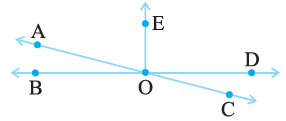
(i) Obtuse vertically opposite angles
Solution:-
∠AOD and ∠BOC are obtuse vertically opposite angles in the given figure.
(ii) Adjacent complementary angles
Solution:-
∠EOA and ∠AOB are adjacent complementary angles in the given figure.
(iii) Equal supplementary angles
Solution:-
∠EOB and EOD are the equal supplementary angles in the given figure.
(iv) Unequal supplementary angles
Solution:-
∠EOA and ∠EOC are the unequal supplementary angles in the given figure.
(v) Adjacent angles that do not form a linear pair
Solution:-
∠AOB and ∠AOE, ∠AOE and ∠EOD, ∠EOD and ∠COD are the adjacent angles that do not form a linear pair in the given figure.